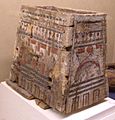Ancient Egyptian concept of the soul facts for kids

The ancient Egyptians believed that a person's soul was made up of five different parts. These parts were called Ren, Ba, Ka, Sheut, and Ib. Each part was important for a person's life and their journey after death.
Contents
The Ancient Egyptian Soul
The ancient Egyptians had a complex understanding of what made a person truly alive. They thought that different parts of the soul helped a person live, think, and even continue their journey in the afterlife.
Ib - The Heart
The Egyptians believed the heart (called Ib) was very important. They thought it held all of a person's emotions, thoughts, and memories. It was seen as the center of a person's being.
After death, the Egyptians believed a person's heart would be weighed. This happened on the scales of the god Anubis, against the feather of Maat, who was the goddess of truth and justice. The outcome of this weighing decided what would happen to the person in the afterlife.
Sheut - The Shadow
The Sheut was believed to be a person's shadow. The Egyptians thought that your shadow was a part of your essence, almost like a twin. It was believed that a person could not exist without their shadow, and the shadow could not exist without the person. It was a unique part of who you were.
Ren - The Name
Your Ren was your name, which was given to you at birth. The ancient Egyptians believed that a person would continue to live as long as their name was remembered and spoken. Because of this, Egyptians worked hard to make sure their names would last forever.
They often carved their names into monuments and surrounded them with a special oval shape called a cartouche. This cartouche was thought to be a magical rope that protected the name.
Ba - The Personality
The Ba is often thought of as a person's spirit or personality. It was believed to be unique to each person, reflecting their individual character. The Ba was often shown as a bird with a human head.
After death, the Ba was believed to be able to fly out from the body. It could travel between the living world and the afterlife. Its main goal was to reunite with the Ka, another part of the soul, in the afterlife.
Ka - The Life Force
The Ka was considered the life force of a person. It was what made a person alive and energetic. The Egyptians believed that the Ka left the body when a person died.
They also thought that Ka was present in food and drink. This is why offerings of food and drink were often placed with the dead. These offerings were meant to nourish the Ka in the afterlife. Egyptian myths suggest that after death, the Ba and the Ka would reunite through a god named Nehebkau before entering the Duat, which was the underworld.
Images for kids
-
An ushabti box from the Ptolemaic Period. On display at the Rosicrucian Egyptian Museum in San Jose, California. RC 623
-
Ostrakon with the beginning of the Ghost story. Terracotta from Deir el-Medina, 19th–20th Dynasties, New Kingdom of Egypt. Found by Ernesto Schiaparelli in 1905. Museo Egizio, S.6619.
See also
 In Spanish: Componentes del ser humano en el Antiguo Egipto para niños
In Spanish: Componentes del ser humano en el Antiguo Egipto para niños





